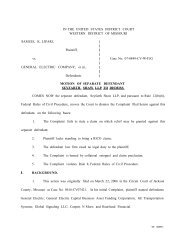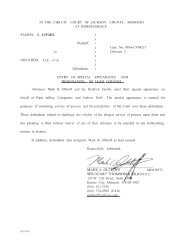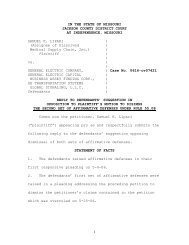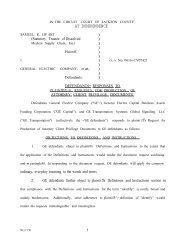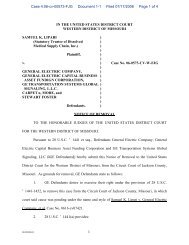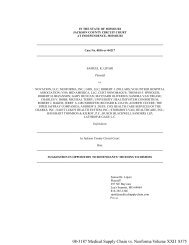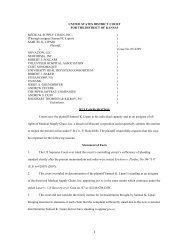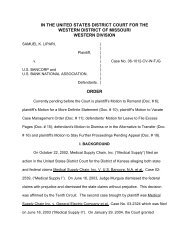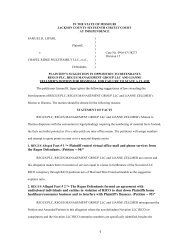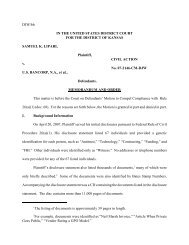Order Granting Motion To Remand - Medical Supply Chain
Order Granting Motion To Remand - Medical Supply Chain
Order Granting Motion To Remand - Medical Supply Chain
You also want an ePaper? Increase the reach of your titles
YUMPU automatically turns print PDFs into web optimized ePapers that Google loves.
Case 4:06-cv-00573-FJG Document 29 Filed 11/29/2006 Page 1 of 5<br />
IN THE UNITED STATES DISTRICT COURT<br />
WESTERN DISTRICT OF MISSOURI<br />
WESTERN DIVISION<br />
SAMUEL K. LIPARI, )<br />
)<br />
Plaintiff, )<br />
)<br />
v. ) No. 06-0573-CV-W-FJG<br />
)<br />
GENERAL ELECTRIC COMPANY, et al., )<br />
)<br />
Defendants. )<br />
ORDER<br />
Currently pending before the Court are plaintiff’s <strong>Motion</strong>s to <strong>Remand</strong> (Docs. # 4,<br />
6) and plaintiff’s <strong>Motion</strong> for a Hearing (Doc. # 8), plaintiff’s <strong>Motion</strong> to Supplement the<br />
Record (Doc. # 14) and plaintiff’s <strong>Motion</strong> for Recusal (Doc. # 24).<br />
I. BACKGROUND<br />
Plaintiff filed his petition in state court on March 22, 2006. Plaintiff named five<br />
defendants in his petition: General Electric Company, General Electric Capital Business<br />
Asset Funding Corporation, GE Transportation Systems Global Signaling, L.L.C.,<br />
Heartland Financial and Carpets ‘n More. The GE defendants are all out of state<br />
residents. Both Heartland Financial and Carpets ‘n More are Missouri residents.<br />
Plaintiff is also a citizen of the state of Missouri. On April 4, 2006, plaintiff served GE,<br />
GE Capital and Heartland Financial. On April 5, 2006, plaintiff served GE<br />
Transportation. On April 27, 2006, plaintiff attempted to serve Carpets ‘n More, but the<br />
summons was returned, non est, apparently because there was no answer.<br />
On May 4, 2006, both the GE defendants and Heartland Financial filed motions<br />
to dismiss. On May 25, 2006, the state court granted Heartland Financial’s motion to<br />
dismiss and denied the GE defendants’ motions to dismiss. The GE defendants state
Case 4:06-cv-00573-FJG Document 29 Filed 11/29/2006 Page 2 of 5<br />
that plaintiff on July 5, 2006 set a Case Scheduling <strong>Order</strong> without serving Carpets ‘n<br />
More, and it became apparent to defendants on that date that plaintiff did not intend to<br />
pursue his claims against Carpets ‘n More. The GE defendants removed the action to<br />
federal court on July 17, 2006. On July 19, 2006, plaintiff filed a motion to remand.<br />
In their Suggestions in Opposition to the <strong>Motion</strong> to <strong>Remand</strong>, the GE defendants<br />
state that “[a]lthough there is no case directly on point, the Case Management<br />
Scheduling <strong>Order</strong> should constitute ‘other paper’ because it constitutes an act by<br />
plaintiff which gives the defendants notice of changed circumstances which now support<br />
federal jurisdiction.” (Suggestions in Opposition to <strong>Motion</strong> to <strong>Remand</strong>, p. 3). The<br />
defendants state that Case Management <strong>Order</strong> sets forth a trial date, mediation date,<br />
deadlines for witness and exhibit lists, etc. They argue that all of these dates were set<br />
without the resident defendant Carpet ‘n More’s ability to participate. Thus, given the<br />
plaintiff’s desire to go forward without Carpets ‘n More, it is now clear that the plaintiff no<br />
longer intends to include Carpets ‘n More in this proceeding.<br />
Plaintiff argues the case should be remanded because the removal was untimely.<br />
Plaintiff states that the removal is untimely because the summons issued to Carpets ‘n<br />
More expired thirty days after it was issued and plaintiff did not seek to renew the<br />
summons against this party. The plaintiff also argues that the defendants have waived<br />
their right to remove by actively participating in the state court action.<br />
II. STANDARD<br />
It is the defendant’s burden to prove that removal is proper and that all<br />
prerequisites are satisfied. See generally, Hatridge v. Aetna Cas. & Sur.<br />
Co., 415 F.2d 809, 814 (8 th Cir. 1969). The removal statute is to be<br />
narrowly construed, and any doubt about the propriety of removal is<br />
resolved in favor of state court jurisdiction. Shamrock Oil & Gas Corp. v.<br />
Sheets, 313 U.S. 100, 108-09 (1941); In re Business Men’s Assur. Co. of<br />
America, 992 F.2d 181, 183 (8 th Cir. 1993). Any technical defect in the<br />
2
Case 4:06-cv-00573-FJG Document 29 Filed 11/29/2006 Page 3 of 5<br />
removal procedure requires a remand unless the plaintiff fails to move for<br />
a remand within thirty days of removal. In re Amoco Petroleum Additives,<br />
Co., 964 F.2d 706, 708 (7 th Cir. 1992); Carroll v. Gold Medal of<br />
Tennessee, Inc., 869 F.Supp. 745, 746 (E.D.Mo. 1994).<br />
Williams v. Safeco Insur. Co. of America, 74 F.Supp.2d 925, 928 (W.D.Mo. 1999).<br />
“Since removal to federal court is a statutory right, and not one granted under the<br />
Constitution, removal jurisdiction must be narrowly construed in favor of the nonremoving<br />
party.” Jeffrey Lake Development Inc. v. Central Nebraska Public Power &<br />
Irrigation Dist., No. 7:05CV5013, 2005 WL 2563043, *2 (D.Neb. Oct. 11, 2005), citing<br />
Shamrock Oil & Gas Corp. v. Sheets, 313 U.S. 100,107-09 (1941).<br />
III. DISCUSSION<br />
The defendants argue that although this case was not initially removable, it<br />
became so when the plaintiff set a Case Management <strong>Order</strong> on July 5, 2006. 28 U.S.C.<br />
§ 1446 (b) states in part:<br />
If the case stated by the initial pleading is not removable, a notice of<br />
removal may be filed within thirty days after receipt by the defendant,<br />
through service or otherwise, of a copy of an amended pleading, motion,<br />
order or other paper from which it may first be ascertained that the case is<br />
one which is or has become removable, except that a case may not be<br />
removed on the basis of jurisdiction conferred by section 1332 of this title<br />
more than 1 year after commencement of the action.<br />
Defendants state that it was from this Case Management <strong>Order</strong> that they first<br />
realized that the plaintiff did not intend to pursue his claims against Carpets ‘n More.<br />
In Power v. Norfolk & Western Railway Co., 778 F.Supp. 468 (E.D.Mo. 1991), the Court<br />
stated:<br />
The Supreme Court developed the standard “voluntary-involuntary”<br />
rule for evaluating removability in Powers v. Chesapeake & Ohio Ry., 169<br />
U.S. 92, 99-101, 18 S.Ct. 264, 266-67, 42 L.Ed. 673 (1898). The rule<br />
requires that a case remain in state court unless a “voluntary” act by the<br />
plaintiff brings about such a change in circumstances that makes the suit<br />
removable.<br />
3
Case 4:06-cv-00573-FJG Document 29 Filed 11/29/2006 Page 4 of 5<br />
Id. at 469. The Court also observed that others courts have drawn distinctions between<br />
voluntary and involuntary acts.<br />
Removal has been permitted if the plaintiff amends the complaint to allege<br />
the federal jurisdiction amount in controversy . . . or plaintiff dismisses<br />
claims against a non-diverse defendant . . . A mutual settlement between<br />
the plaintiff and the non-diverse defendant can make a case ripe for<br />
removal. . . . However, dismissal of a non-diverse defendant after granting<br />
a directed verdict (in his/her favor) or granting a summary judgment<br />
motion in favor of the non-diverse defendant (thereby dismissing claims<br />
against him/her) is not considered voluntary as to the plaintiff and<br />
therefore, does not make the cause removable.<br />
Id. at 469-70 (internal citations omitted).<br />
In Stamm v. American Telephone & Telegraph Co., 129 F.Supp. 719 (W.D.Mo.<br />
1955), the Court considered a case with very similar facts to the instant case. In that<br />
case, the summons issued for defendant Tatum, a Missouri resident, was returned<br />
unserved and no alias summons was issued for him and he was never served with<br />
process. The defendants in that case removed the case arguing that the plaintiff had<br />
abandoned his action against Tatum. The Court in that case stated:<br />
It is quite well-settled that if the plaintiff voluntarily dismisses,<br />
discontinues, or in any way abandons, the action as to the resident joint<br />
defendant, the cause then becomes removable, and may, upon prompt<br />
action, be removed by the nonresident defendants who have been served.<br />
. . . But what has this plaintiff done that can be said to amount to a<br />
voluntary dismissal, abandonment, or discontinuance, of the action as to<br />
the defendant, Tatum All that petitioning defendants point to is that,<br />
since the non est return, made January 28, 1953, on the summons issued<br />
for defendant Tatum, plaintiff had not, prior to the removal on March 3,<br />
1955, sued out an alias summons for him. I have not been able to find a<br />
case holding that this shows, and I do not believe it shows, a voluntary<br />
dismissal, abandonment, or other discontinuance, of the action by the<br />
plaintiff as to the defendant, Tatum, and, hence, it cannot be said that<br />
plaintiff, up to the time of this removal, had voluntarily dismissed,<br />
abandoned, or discontinued, the action as to the defendant Tatum.<br />
Id. at 721 (internal citations omitted).<br />
Plaintiff in his <strong>Motion</strong> for <strong>Remand</strong> states that he did not file any motion or take<br />
4
Case 4:06-cv-00573-FJG Document 29 Filed 11/29/2006 Page 5 of 5<br />
any affirmative action to request that the state court issue a Case Management <strong>Order</strong>.<br />
Rather, plaintiff states that this <strong>Order</strong> was entered by the state court sua sponte. The<br />
Court agrees that the issuance of the Case Management <strong>Order</strong> was not a voluntary<br />
action on plaintiff’s part, but rather an action taken independently by the Court. The<br />
Court in Aydell v. Sterns, 677 F.Supp. 877 (M.D.La. 1988) stated, “[t]he ‘voluntaryinvoluntary<br />
rule’ is an outgrowth of the generally accepted proposition that plaintiff<br />
controls the choice of forum throughout the proceedings. . . . Where plaintiff by his<br />
voluntary act has definitely indicated his intention to discontinue the action as to all nondiverse<br />
defendants, the case then becomes removable.” Id. at 880 (internal citation<br />
omitted). The Court does not find that plaintiff took any action which indicated his<br />
intention to discontinue the action against the nondiverse defendants. Therefore, the<br />
Court finds that this case is not removable. The Court hereby REMANDS this case to<br />
the Circuit Court of Jackson County, Missouri. The Clerk of the Court is directed to mail<br />
a certified copy of this <strong>Order</strong> to the Clerk of the Circuit Court of Jackson County,<br />
Missouri as required by 28 U.S.C. § 1447(c).<br />
IV. CONCLUSION<br />
Accordingly, the Court hereby GRANTS plaintiff’s <strong>Motion</strong> to <strong>Remand</strong> (Docs. No.<br />
4,6); GRANTS plaintiff’s <strong>Motion</strong> to Supplement the Record (Doc. # 14); DENIES<br />
plaintiff’s <strong>Motion</strong> for a Hearing (Doc. # 8) and DENIES as MOOT plaintiff’s <strong>Motion</strong> for<br />
Recusal (Doc. # 24).<br />
Date: November 29, 2006<br />
Kansas City, Missouri<br />
S/ FERNANDO J. GAITAN, JR.<br />
Fernando J. Gaitan, Jr.<br />
United States District Judge<br />
5



